Peter MALONE
Saturday, 18 September 2021 19:43
She / 1965
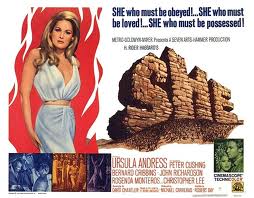
SHE
UK, 1965, 106 minutes, Colour.
Ursula Andress, Peter Cushing, Bernard Cribbins, John Richardson, Christopher Lee, Andre Morell.
Directed by Robert Day.
She is one of the many versions of H. Rider Haggard’s novel. Haggard also wrote King Solomon’s mines. His adventures take place in the exotic Middle East and Africa, lost kingdoms, searches for wealth …
Peter Cushing appears as an archaeologist who travels to the Middle East with his nephew, played by John Richardson. Cushing had become a standard in this kind of film from the 1950s at Hammer Studios with his appearances in the Frankenstein and Dracula films. He also appeared in a number of films like this including The Land That Time Forgot. John Richardson, who was to appear the next year with Raquel Welch in One Million BC, is his nephew. The film also includes a number of British character actors.
However, the focus was on Ursula Andress as Ayesha, the ruler of an ancient kingdom: She Who Must Be Obeyed. Andress had made a big impression in 1962 in Doctor No, the first of the James Bond films.
This is exotic, boys’ own adventure kind of action – with the glamour of Ursula Andress. There was a sequel, The Vengeance of She which also starred John Richardson.
1. The original story was a classic. Do you think the film sequence is classical? The tone of the title and the character She? How ordinary was the treatment, was it geared to popular enjoyment?
2. How impressive were the exotic sets? The background of religion and the treatment of legend? What type of audience response were the film makers after?
3. What were the main features of the myth concerning She? Why would it appeal to audiences of all times? The perennial facets of legend? The quest of immortality, the possibility of immortality without death? The power of love, murder for immortality, self sacrifice, jealousy, anbition and greed, the lust for power? How were these elements embodied in the myth of She? How well explored and presented were they in the film?
4. How convincing was the initial setting of Jerusalem? The bar, the people present, the ordinariness of the English, Leo himself, Peter Cushing as a professor, and Bernard Cribbins as Job? (Was the latter out of place with his music hall routines?) The atmosphere of mystery and the renewal of the mystery for them?
5. Could the audience identify with these characters? With Leo and his quest? With the professor?
6. The appearance of Ustany - the air of mystery about her? Audience sympathy for her? That she became the victim?
7. How well done were the techniques of illustrating the journey via the map and the locations? The quality of the photography? Atmosphere of desert remoteness, of fantasy? Suffering and being saved by Ustany?
8. How mysterious was Ayesha? Ursula Andress’ performance and appearance? Had she the quality of myth? Could she inspire such loyalty and love? Audience response to her? to the truth of her power? Of her need to be saved? Could audiences understand Leo's infatuation with her and love?
9. Comment on the portrayal of life in Kuma? Was it credible? Or was it Saturday matinee style?
10. How convincing a villain was the high priest Billali? which sequences best illustrated his villainy? The lust for power and the clash with Ayesha?
11. How did this contrast with Haumeid and his followers? The war scenes and barbarity?
12. The barbarity of Ayesha, her torturing of people, the pit, her torturing of Ustany? Was this barbarity compatible with the beauty of Ayesha? The background of the myth and her murdering her lover?
13. The significance of the flame and the moon? Was this treated convincingly?
14. Did you expect Ayesha to wither away and decay? The visual effects for the convincing portrayal of this? Its impact on the audience, on Leo?
15. The sense of destiny, the destruction of Ayesha, of Billali? Leo going into the fire and having to wait for hie chance of redemption?
16. Why are films combining myths, fantasy lands, Eastern background, horror always enjoyable to popular audiences?
Published in Movie Reviews
Published in
Movie Reviews
Tagged under
Saturday, 18 September 2021 19:43
She and He / L'assoluto Naturale
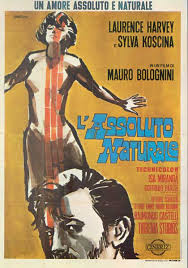
L’ASSOLUTO NATURALE (SHE AND HE)
Italy, 1969, 90 minutes, Colour.
Laurence Harvey, Sylva Koscina, Felicity Mason, Isa Miranda.
Directed by Mauro Bolognini.
She and He is a two-hander film, based on a play called The Natural Absolute. It has a portrait of a man, played by Laurence Harvey, and his relationships with women. It has a portrait of a woman, played by Sylva Koscina, who balances the portrait of the man.
The film was directed by Mauro Bolognini who had directed a number of realistic films in Italy in the 1950s and 60s, like Il Bell’ Antonio. However, during the 1970s he made a number of beautiful Italian melodramas, set in the past: Down the Ancient Staircase, The Ferramonti Inheritance, Metello.
1. The total impact of the film? The work of this Italian direrctor? The criticisms against its being confined to two characters, the blend of realism and symbolism? For whom was the film made? Italian audiences, non-Italian?
2. The focus of the title on masculine feminine and the interrelationships? Love and confict? Passion and love, passion and hatred, passion and death? The implications of the anonymous man and woman in the modern world? The title of the original play was The Natural Absolute: meaning, implications?
3. The focus on cinema techniques for communicating themes of masculine/feminine? The long credits with the focus on statuary, poses, love? The use of colour, music? The blending of old world and new? Hotels and wealth, garages and ordinary people? The rogue, homes? The cemetery? The blending of fast and slow paces?
4. The focus on male/female relationships, psychology, sexuality? Appearances and reality? Ideal or non-ideal? The focus on understanding masculinity in itself? Femininity?
5. The relationship of male and female? The nature of attraction? Influence? Infatuation? Love and intuition? Surface attraction and behaviour? Love, possession? The effect of mutual change or not? Who remains absolute, who influences the other? The relationships as satisfying, the longing for more? Violent and destructive, constructive? How well were these aspects illustrated by particular incidents?
6. The film was based on a play. Was this evident? An atmosphere of contrivance in dialogue and situation? The speaking of the dialogue in English in an Italian film? The way that it was spoken, uttered, declaimed? Laurence Harvey's rhetorical style? The devices of drama distancing the audience, involving them? How much alienation of the audience, how much invitation to insight?
7. The portrait of he, his role in the cemetery, photography and the elusive woman, romanticising the woman, idealising her, infatuation, love? The motivation for following? Giving to her but not changing
and being unwilling to change even though demands ware made? The variety of incidents and his response? The portrait as a character, as a type? Insight into man?
8. The portrait of she: in the cemetery, leading him on? Her possessions in the car, the teasing at the car wash? Her leading him on in the driving fast, the supermarket? The road, the garage, taunting to jealousy with the other men? The hotels? How ideal was she, real? Possessing him? Interested in practicalities? Her domination? Did she change? could she change?
9. The gradual development of the relationship and the interplay between the two especially in the love sequences: nature of passion, dominance, transience and permanence?
10. The emphasis on soliliquies on the part of the man, the background her family, his jealous watching? Ultimately leading to death?
11. She and her relationship with others e.g. at the swim, family, the buildup to her destructive power?
12. The sequences in the car, the importance of the crash?
13. The representation of the family and the matriarchal system? The symbol and the meaning of the silkworm parable and reality?
14. The buildup to she destroying him? The visualising this on the road? Her passing by, his remaining dead?
15. How pessimistic a portrait of human nature, of human relationships? A pessimistic outlook on the possibility of masculine/feminine love and hate?
Published in Movie Reviews
Published in
Movie Reviews
Tagged under
Saturday, 18 September 2021 19:43
She Lives

SHE LIVES
US, 1973, 75 minutes, Colour.
Season Hubley, Desi Arnaz Jr Anthony Zerbe, Michael Margotta.
Directed by Stuart Hagman.
A love and death story. The heroine says that the film is not love story and real life. However, there are many similarities, except that the heroine rages against her fate. It is a story of sixties type students and young men and women. A couple, an odd couple, livigg together discover in their happiness that the heroine is to die. The hero decides that he must help her to live and goes to no end of searching for cures for the heroine. The story is trite enough on paper. However, Season Hubley and Desi Arnaz Jr are very effective in the central roles and make this material quite credible.
There is a lot of sensitivity and feeling in the film for soap opera. Season Hubley was to have greater success in the late seventies with the film Elvis and Hardcore. Desi Arnaz Junior has played similar sympathetic roles in Red Sky at Morning and Black Market Baby. He appeared in Robert Altman's A Wedding as the groom. The direction is by Stuart Hagmann who made the campus film The Strawberry Statement and the drugs film Believe in Me. She Lives is fine emotional drama for the television audience.
1. The basic appeal of the material: the love story, despite Pam’s disclaimer about her story not being love story? Love, serious illness, the prospect of death, hope? Audience identificlation, sympathy? quality of presentation of these themes?
2. The telemovie presentation for home audience, impact? Through the medium of television with its pauses, home distractions for the audience? A serious treatment of themes, emotional involvement?
3. The young couple of the sixties and seventies? Youth and the differences from the stability of the past? Parents and their severity? The inculcation of goals and the changes in goals? Study, scholarships, exams? Jobs and work? The picture of Los Angeles ind San Francisco? An authentic atmosphere?
4. The significance of the title, its hope, Andy saying and writing it at the end? The musical score, the continued use of the song and its illustration of the themes, its plaintive mood?
5. Season Hubley and Desi Arnaz and their sensitivity, sympathy? their embodying their roles, their natural interaction with each other? How persuasive in terms of themselves, their loving relationship, Pam’s illness, Andy's search for healing? His communicating this hope to her?
6. The portrait of Andy? his background, the episode with the death of the rats, his sensitivity, his clashes with his father and his father's rejection of him by letter? His advertisement, reading the replies in the toilet and his reaction,
his placing the notes in the records and meeting Pam?
7. The encounter with Pam, their talking, the film establishing their compatability, friendship, love? Discussion of problems? Their sharing, the house, the clash with Al? Andy's decision to be faithful to Pam, their anniversary?
8. The sculpture, the phone calls to Pam, the buying of the record? The possibilities for a happy future?
9. The sudden indications of Pam’s illness, the tests, her violent reaction? The doctor and his information, treatment of Andy? Her violent reaction in the house? Her treatment, depression? Pam as an energetic character, an attractive girl, faced with the prospect of dying? her fearful reaction?
10. Andy and his support, his love, energy, his willing her to be better? The sequence where he persuaded her to hope in living? The effect on her? Their study, examination of cases, the contact with Okisawa and the bonds with him? his showing the test results, helping Pam, visiting the house (and the police and neighbours' curiosity?), his continued advice?
11 Pam’s desperation and the suicide attempt, Andy's offering himself and her reaction?
12. The phone call to Dr. Welman, the decision to go to San Francisco, hitchhiking, the visit? his being on the phone, not wanting to be involved, his explaining his responsibilities and his status as a scientist, playing darts, courtesy? his saying that he was cornered, the treatment and Andy's involvement in it, the tests, the 'flu? The final results and some remission for Pam?
13. The happy finale with the two in the San Francisco street, getting a job, the hope for some kind of future, the joy at the end, she lives?
14. How well did the film communicate the reality of terminal illness, medical help and its limitations, the need for support and strength, the psychological repercussions on the person dying, on the person helping? Themes of hope?
Published in Movie Reviews
Published in
Movie Reviews
Tagged under
Saturday, 18 September 2021 19:43
She Runs in the Suburbs/ The Suburbs are Everywhere/ Elle Court, Elle Court La Banlieue
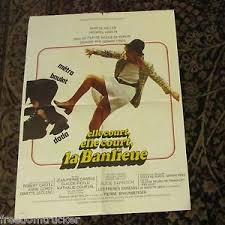
ELLE COURT, ELLE COURT LA BANLIEUE (SHE RUNS IN THE SUBURBS/ THE SUBURBS ARE EVERYWHERE)
France, 1973, 95 minutes, Colour.
Marthe Keller, Jacques Higelin, Victor Lanoux, Daniel Prevost, Claude Pieplu.
Directed by Gerard Pieres.
The Suburbs Are Everywhere is a domestic drama, focused on life in Paris. It shows the struggle of a young man and woman to set up their home in Paris, cope with their work, cope with the various pressures of life.
The film is attractive, especially with its stars, Marthe Keller and Jacques Higelin. The film was directed by Gerard Pieres who directed only eighteen films over a period of forty years (including the box office action success, Taxi, in 1998). The film is what one might call typically French, typically Parisian.
1. How entertaining a film was this? Why? Did it seem real or exaggerated? Or both? audiences easily identify with these characters? How ironic was the title?
2. Comment on the style of the film - its rather hurried tone, the amount of noise and shouting, the incidents of working life and home? farcical situations, the comedy? Did these all add up to entertaining insight into life in the suburbs? Were some of the characters and situations too much cliche? If so. did this matter? Was the film particularly French, or did it apply to most city dwellers?
3. What was the purpose of the film ? a laugh, a comment on society, criticismof society? All of these? How successful were the film-makers?
4. What was the moral of the story? Marriage in the modern world? The pressures of work? The pressures of mechanisation? The pressures of the city? The pressures of one's neighbours? Moral pressures? How well did the film look into these and make its point?
5. Comment on the visual presentation of city life and its pressures. What were the main ones the film was concerned with? How tellingly?
6. Why did people seem so awful in this film? The character said people were awful.. Were they? Could they be otherwise? Even Marlene and Bernard were awful at times.
7. What insight into modern marriage and love did the film give? Marlene and Bernard and their marriage? The decisions to be married? The ceremony, the hunting for a house or for flats (and the awful satire here?) The neighbours, work, (the irony of the couple who met only in the paesing trains), the noise and the salesman? The temptations to infidelity and to desperation? How real were these? Did the happy ending show that they could be overcome? Convincingly?
8. How did the film show the ups and downs of the central couple? How enjoyable were these, yet how real?
9. What did the neighbours add to the film? The young couple with the boorish husband, the flighty wife, her adultery and her being caught, the baby being looked after downstairs, her support of Marlene? How ordinary were these people and how well were they observed?
10. The policeman and his wife - caricatures? How awful? The wife stealing and egging the husband on? The husband and his shouting, his comment on the riots, his model planes? Were these people real and their problems real?
11. The satire on the bosses - and taking pills, the piles of transferring people etc?
12. The waitresses at the restaurant where Bernard stopped - their looking for pickups, their behaviour towards wives etc.? Was this real of exaggerated? Was the waitress attractive enough for Bernard to walk out?
13. Was the film serious in its presentation of depression and suicide? Could you believe that Marlene would attempt suicide? How realistic was the ambulance chase to the hospital? Even if this was not real, what point was being made? Effectively?
14. How well did the film blend satire and comedy? Which details appealed to you most and illustrated this best?
Published in Movie Reviews
Published in
Movie Reviews
Tagged under
Saturday, 18 September 2021 19:43
Sheepman, The
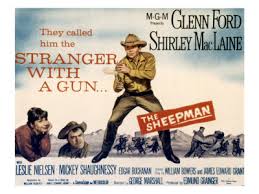
THE SHEEPMAN
US, 1958, 85 minutes, Colour.
Glenn Ford, Shirley Mac Laine, Leslie Nielsen, Mickey Shaughnessy, Edgar Buchanan, Pernell Roberts, Slim Pickens.
Directed by George Marshall.
The Sheepman is a very pleasant and entertaining western. Glenn Ford portrays a man who has won a flock of sheep in a poker game and brings it to a cattle town. Needless to say, the inhabitants are not too pleased and rely on their leader, Leslie Nielsen, to confront the sheepman. However, there are complications in the past relationship between the sheepman and the leader.
Shirley Mac Laine appears to her advantage, early in her film career, as a rough and ready western type – anticipating her Two Mules for Sister Sarah ten years later.
The film is amusing as well as a film with some action. It was directed by George Marshall, a veteran director of westerns including Texas (with Glenn Ford) and Destry Rides Again, a number of Martin and Lewis comedies. He worked so well with Glenn Ford that his next five films were with Ford. They are The Gazebo, Imitation General, The Mating Game, It Started With A Kiss and Cry For Happy. He also directed him in Advance to the Rear. Glenn Ford was one of the most popular actors in Hollywood during these years and was prolific in the number of films that he made.
1. A successful blend of comedy and Western ?
2. The use of Cinemascope, colour, locations, atmosphere, music and songs?
3. The title and its reference to Jason, the clash with the cattlemen? The significance of a rebel and a man with a difference? Its relationship to Jason's wheat? The humorous portrayal of his arrival, the details of his aggressiveness at outsmarting the residents, his relationship with Milt and outsmarting him? The initial clash with Della? The staged fight with Jumbo? The encounter with the colonel and the revelation of the previous encounters? His humour, wit, the scene where he bought things for his ranch? How strongly delineated was his character? The
revelation of the sheepman?
4. How well did the film present the sheep and cattle issues? The background of the range war? The availability of land, the suspicions of the cattle people as regards sheep and the threat to the cattle? The fears leading to violence?
5. How attractive, a character was Jason? his explanation of his background, his stubbornness, his relating to people but not wanting to be popular ? The using of people, their liking him? His attitude towards his sheep, getting them off the train, his assistant? The contrast with the colonel and his phony respectability, change of name? The background of the gunfight, the colonel's robberies and the killing of Jason's fiancee? The fencing, hostility, using Della?
6. How attractive a character was Della, a girl from a cattle town, her father, engaged to the colonel? The importance of their encounters, the fact that she betrayed him?
7. The build-up of the atmosphere of the dance, Jason’s enjoying it, the colonel’s suavity, Milt’e suspicions? All the girls dancing with Jason and then the revelation of the trick?
8. The irony of the return with the sheep and Jason confronting the people at the dance?
9. The upper hand with the revelation of the truth about the colonel and his money deals in Washington, the people being disillusioned with him?
10. The conventional portrayal of hired killers their violence, the staged gun fights, deaths and the help of Milt and Della?
11. The dramatic build-up to the confrontation between Jason and the colonel ? The colonel's death?
12. How attractive was the happy ending? Inevitable and appropriate for this kind of film?
13. The film’s portrayal of success in the West? American type genial attitude towards the American past?
Published in Movie Reviews
Published in
Movie Reviews
Tagged under
Saturday, 18 September 2021 19:43
Sheriff of Fractured Jaw, The
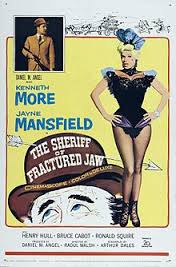
THE SHERIFF OF FRACTURED JAW
UK, 1958, 103 minutes, Colour.
Kenneth More, Jayne Mansfield, Henry Hull, Bruce Cabot, Ronald Squire, William Campbell, Sid James, Robert Morley.
Directed by Raoul Walsh.
This is a British western. Kenneth More portrays a young man who wants to improve his uncle’s company’s sales, especially of guns, by going to the west. On a stagecoach, he gains the reputation for holding off an Indian attack. He is then reputed to be a quick on the draw cowboy and is nominated as the sheriff of Fractured Jaw. He survives a whole lot of comic adventures, aided by the advice of the glamorous Jayne Mansfield.
The cast includes a mixture of veterans from Hollywood westerns like Bruce Cabot and Henry Hull along with some British in the supporting cast, including Sid James as a drunk.
The film was directed by Raoul Walsh who had begun his career in the second decade of the 20th century, had directed all during the silent era, made a big impact with The Big Trail and other action adventures in the 1930s and continued during the 1940s and 50s to direct a wide range of popular films.
1. How entertaining a comedy Western? The title and its significance, the irony of the name?
2. The film was British. A British look at the West and its conventions? Parody and satire? What were the main conventions of the Western used, how well? The Sheriff, Indians, the Ranchers and the ranch war? Shootouts? The saloon and the lady of the saloon, romance?
3. The quality of the photography, colour, Western acts and locations, music?
4. How credible was the plot? Was this important? The humour and satire in the British background, Uncle Lucius and the Firm, Jonathan Tibbs and his selling of guns?
5. The Englishman's look at the West? Comment on Jonathan Tibbo's character, his behaviour in England, in America, his treatment of the West as if it were England? The irony of his success with the Indians, with the town gun-shooters, with the ranchers? Becoming an Indian son? His relationship with Kate and romance? Strengths of character, weaknesses? An ironic hero for this kind of film? How well matched was he by Kate? The conventional saloon owner? Her singing, the, romance? Her helping him at the end?
6. Comment on the villains, the gun-shooters, the men of the West? The presentation of the Indians, being routed by Jonathan Tibbs, grateful to him. coming to his rescue?
7. How well handled were the various episodes, the stage coach, the drinking and shooting, the fight at the end?
9. How humorous was the film in its satire on the West? Any insight into the West?
Published in Movie Reviews
Published in
Movie Reviews
Tagged under
Saturday, 18 September 2021 19:43
Sheriff, The

THE SHERIFF
US, 1971, 73 minutes, Colour.
Ossie Davis, Kaz Garas, Ruby Dee, Kyle Johnson, John Marley, Ross Martin, Lynda Day George, Moses Gunn, Brenda Sykes, Joel Fluellen, Ed Binns.
Directed by David Lowell Rich.
The Sheriff sounds as if it is a western. It is not. This is a brief telemovie from the early days of Universal Studios’ television movies. It is set in a small town and the focus is on racial tensions. The focus is an accusation of rape against a white businessman, a wealthy man, who is alleged to have raped a college student, who is black. Ossie Davis, black himself, is the sheriff and his has a white assistant investigating the allegations.
Ossie Davis appears with his wife, Ruby Dee.
The film is brief, makes its points with some vigour – but designed also for the wide home audience watching the film on television.
1. How interesting and entertaining a film? As a television movie?
2. Comment on the telemovie techniques, the conventions, their use?
3. How real did this world seem? How authentic the people and places? How real and demanding the issues? As an echo of America and the world of the seventies?
4. The importance of the law and police framework as a test of values for this kind of movie, for these issues? The importance of law and police in the early seventies? Reaction against the police? The popularity of police television shows at the time?
5. How interesting and convincing a person was the sheriff? His being pictured in his job, an elected black man as sheriff of this county, an upright man in himself, a good man relating well to his family? The sequences of his hunting with Vance?
6. The crisis which he underwent: the rebellion of his son, the impact in his home, the colour implications? How well did he handle the situation, humanly, legally? His insight into what people would do? The nature of the confrontation with Waters? His dependence on the deputy? His forcing Mr. Kinsella’s hand for a warrant? Insight
into the integrity needed for being a sheriff?
7. The importance of the support of his wife, her relationship to Vance and trying to make him see the sheriff’s point of view?
8. The importance of the focus of rape? Its impact on those concerned? The physical hurt, psychological damage, invasion of privacy, implication of relatives, public gossip, law courts and the administration of justice? How convincingly were these aspects communicated?
9. The racial themes and their exploration? Walters as a taken-for-granted, bigoted man? Echoed by the deputy’s wife? The deputy in between his wife and the sheriff?
10. The decision in court as a breakthrough in justice for blacks? The deputy’s wife giving testimony? As an example of the breakdown of racial prejudice?
11. How well did the film portray Walters' personality and not just make him a cardboard figure of evil? The rape sequence and the lead-up to it? His being pictured in his job, in court with his lawyer? His trying to wriggle out of the case, his vindictiveness? Janet and her father? How convincingly portrayed? The effect of the rape on Janet, her relationship with Vance and his being rude in public? Her courage in the courtroom? The vindictiveness of her father? His attempt on Walters? His being ousted by the sheriff?
12. How important was Vance's rebellion against his father? The change in attitude of love to suspicion? Impatience about civil rights? The sequences at home and his refusal to come to dinner? The words of his mother and father? The car chase and Vance's attempt after? How much did he learn?
13. Mr Kinsella and the authorities in the town?
14. The character of the deputy and his relationship with his wife? The revelation of her evidence? The breaking down of her prejudice? How important for the themes?
15. How well did this short film focus moral issues for a television audience?
Published in Movie Reviews
Published in
Movie Reviews
Tagged under
Saturday, 18 September 2021 19:43
Sherlock Holmes in New York
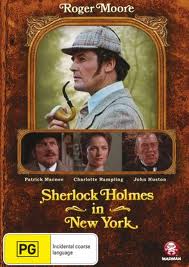
SHERLOCK HOLMES IN NEW YORK
US, 1976, 93 minutes, Colour.
Roger Moore, Patrick Macnee, Charlotte Rampling, John Huston, Gig Young, Signe Hasso, Leon Ames, Jackie Coogan.
Directed by Boris Sagal.
A very entertaining telemovie, made with care and style. Conan Doyle's detective and his assistant Dr. Watson have always been popular from the times of silent films. Basil Rathbone seemed to incarnate the detective. In the seventies there were various humorous and fictitious attempts to explore Sherlock Holmes and his character as well as portray the stories - for example Billy Wilder's The Private Life of Sherlock Holmes with Robert Stephens and Colin Blakely, Mel Brooks's style humour with Gene Wilder as Sherlock Holmes's Smarter Brother, Peter Cook and Dudley Moore clowning in The Hound of the Baskervilles and the elegant Seven Per cent Solution where Nicol Williamson as Sherlock Holmes met Freud (Alan Arkin).
This is a fictitious story of Holmes and his love for Irene Adler and his confrontation with Moriarty. Roger Moore is an unusual selection for Sherlock Holmes and is perhaps a bit contemporary and bland. However, Patrick Macnee (John Steed of The Avengers) is excellent as Dr. Watson (playing in the Nigel Bruce fashion). Charlotte Rampling is an alluring Irene Adler. John Huston turns Professor Moriarty into an Irish archvillain. There are good supporting performances from such veterans as Signe Hasso as a governess and Gig Young as McGray? the banker. Sets and decor are excellent and the film has the light touch - aided by the score of Richard Rodney Bennett. Direction is by Boris Sagal, who directed such films as The Omega Man and many telemovies.
1. The appeal of Sherlock Holmes? The perennial appeal over the decades? The character of Sherlock Holmes, the archetypal detective? His personality, characteristics? Dr. Watson and the combination of the two? The atmosphere of the period? The elementary detecting techniques?
2. The inventiveness of the screenplay? How well did it cohere with Conan Doyle's conception of Holmes, Watson, Moriarty? With Conan Doyle's stories? The adaptation of Sherlock Holmes for an audience of the seventies?
3. The qualities of the film as a telemovie? The cast, acting skills, décor, score? The blend of the detective story with comic touches? Interest sustained for the home viewing audience?
4. How successful was Roger Moore as Sherlock Holmes? Audience expectations about Holmes - his appearance, manner, speech, detection? Expectations of Roger Moore from his screen and television roles especially as hero and detective? Holmes as detective, his melancholy habits, violin, drugs, etc.? The romance in Sherlock Holmes's life and the place of Irene Adler? The confrontation with Moriarty? Holmes’s achievement, arrogance and complacency, human touches?
5. Audience interest in Irene Adler and Sherlock Holmes? The background of their love? Irene's son and his similarities with Sherlock Holmes? The establishing of the relationship between the two and Moriarty's use of the relationship: the theatre tickets and their tradition, the charred tickets, the break between the two and the perpetual love, the son, Holmes's rushing to New York, rescuing Irene, rescuing her son? The importance of Irene accusing Holmes of fear? His inability to relate fully to her? A side view of Holmes’s humanity?
6. The character of Iroene, Charlotte Rampling's appearance, presence? As an actress, her initial distress, her admission of the kidnapping, her concern for her son and joy to have him back, the importance of her speech about Holmse's fear, her happiness at the end?
7. Patrick Macnee's style as Dr. Watson? Audience expectations of his character? As doctor, slow, lacking in humour? His contributions to Holmes's detection? The humour of his anti-New York and American comments? A foil to Holmes?
8. Moriarty as the personification of evil? John Huston's appearance, Irish accent? The initial confrontation and the threats, the boast of the crime of the century, his presence in New York and his minions, his overall plan and its achievement, the menacing room and his escape? The kidnapping of the boy? His living for another day and challenge to Holmes?
9. The theatricality of Sherlock Holmes? His various disguises? The opening confrontation with Moriarty, his disguisinghimeelf as the Italian for the regaining of Irene's son, the fanatic with his poster of The End Is At Hand? Holmes's ability to elude people, his theatrical imagination?
10. The character of Moriarty? The embodiment of evil? His challenge to Holmes? The overall plan, the crime of the century, the use of the tickets, Holmes's visit to the theatre and his ability to spy on him, to get him back to Irene's home, his presence in New York, the warehouse as headquarters, his betraying his friends, the whole gold plan?
11. The character of the police inspector? Their interrogation of Holmes and asking for his alliance and their dismay at Holmes's not collaborating with them? Holmes's reasons? The room with the gold missing? The contrast of the room full of gold?
12. The minor characters - the watchers outside Holmes's hotel. Moriarty's minions, the governess and her demonstration about the kidnapping of the boy, the kidnapping actress? Set scenes such as the interviews. the eluding of the watchers, the rescue from the hotel, Moriarty and the elaborate chase throughout the streets of New York?
13. The fact of Moriarty living to fight another day and Holmes ready to combat evil? Why are Sherlock Holmes stories so enjoyable?
Published in Movie Reviews
Published in
Movie Reviews
Tagged under
Saturday, 18 September 2021 19:43
Shipwreck/ The Sea Gypsies
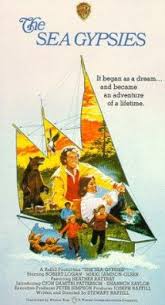
SHIPWRECK (THE SEA GYPSIES)
US, 1978, 102 minutes, Colour.
Robert Logan, Heather Rattray, Mikki Jamison- Olsen.
Directed by Stewart Raffil
A well made family film by Stewart Raffil, the maker of 'Across the Great Divide'. Colourful adventure, credible enough people, a minimum of sentiment, good adventure sequences. Fine American f ilm-making for the family.
1. The impact of a family film and its being directed towards all members of the family? Audience expectations from this kind of film? From the title?
2. The quality of location photography, the atmosphere of Alaska and the sea and its mountains and rivers, the animals and the variety of wild life?
3. The credibility of the plot: the start and the preparations for the voyage, T.V. interviews, Kelly and her going aboard? The achievement of the sailing and surviving the shipwreck? Audiences identifying with the characters?
4. The visual presentation of the ship, life on the ship? Travis and the bond with his daughters? His ability in manoeuvring the ship? Kelly and her learning? The black boy stowing away, falling over, being rescued? Their working well and enjoying the voyage? The tranquility and beauty of the sea?
5. Comment on the domestic sequences within the ship and the rapport between the persons on it.
6. The build-up to the storm, its violence, their plans to abandon ship, the wreck and their surviving, landing on the beach?
7. How well did the family cope? Alaska and the seasons, the rivers, mountains? The cliffs? How well did each of the members cope - the children, Travis, Kelly, the boy?
7. Preoccupations with hunting and the scenes with the door, the buffalo? Adventure? Sentiment with the deer mother? The cold, the rain, fishing? The building of the hut?
8. The presentation of the animals - the deer, the buffalo, the wolves, the bear and its various attacks and the danger of violence?
9. The evidence of the plane wreck and Travis hiding from the bear within it? Kelly and her discovery of the mauled man and the pathos of his diary? The possibilities for themselves?
10. The importance of building the boat, the diving for the material from the wreck, the sequence with the whale and its danger? The celebrations? The working together? The love between Kelly and Travis?
Published in Movie Reviews
Published in
Movie Reviews
Tagged under
Saturday, 18 September 2021 19:43
Shocking Miss Pilgrim, The
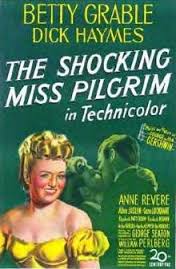
THE SHOCKING MISS PILGRIM
US, 1947, 85 minutes, Colour.
Betty Grable, Dick Haymes, Anne Revere, Allyn Joslyn, Gene Lockhart, Elizabeth Patterson, Elizabeth Risdon, Arthur Shields.
Directed by George Seaton.
The Shocking Miss Pilgrim is a very pleasing vehicle for Betty Grable. She is Cynthia Pilgrim, who had graduated from business school in the 1880s and becomes a stenographer, mastering the new typewriter. She shocks people by working away from home, gets a job in a shipping company in Boston. Although the men object to her presence, she is able to charm them all, including the boss. However, she also becomes involved in the suffragette movement, endangering her job and her relationship with the boss.
Needless to say, there is a happy ending.
Betty Grable was very popular during the 1940s, especially for being a pin-up for the GIs. Dick Haymes was a popular crooner at the time.
The film was directed by George Seaton, a prolific writer, whose first major film direction job this was. He was to make The Miracle on Thirty-Fourth? Street the same year. As he moved into direction, he made a number of conventional comedies like For Heaven’s Sake but also significant films like The Country Girl. He also directed, in 1970, Airport.
1. The tone of the title? How enjoyable a film - as comedy, a musical, as a human interest story?
2. Comment on the quality of the production? A film of the late 40s, colour, the style, the romantic atmosphere, the comedy? Does it seem dated? how well can it be appreciated now?
3. The feminist theme: as an illuatration of thinking about women in the 1940s? The 1940s looking back to the 1870s? The response to this theme now? What attitudes towards women, their place in the world, their work, prejudices against them did the film offer?
4. Comment on the use of the atmosphere of secretaries for the feminist theme. The prejudice of people against secretaries, typewriters, women working in offices etc. How enjoyable was this as comedy? How ironic as reality?
5. How attractive was Betty Grable as the heroine? What kind of woman was she in herself? Her forcefulness, her relationship with man, her pride in her work? Her love for her employer? Her involvement with his aunt and the women's demonstrations? Her belief in woment right and role? The relationship with her employers mother? The fact that she had prepared nastily for the meeting. and the reality was so much better? Her relationship with the eccentrics in the house? (The anti-Boston tone and its later mellowing?) Was Dick Haymes an effective hero? His prejudices against women, his falling in love with Cynthia, his involvement in the women’s movement, his relationship with his aunt. his mother?
7. How enjoyable was Anne Revere's performance as the aunt? The sequences of the women’s demonstrations? The songs and the slogans, the swastikas and the points being made?
8. The characters in the office: satire on men, theassistant, prejudices etc?
9. How well did the film illustrate the chbices for Cynthia Pilgrim as regards marriage and women’s demonstrations?
10. How effective were the songs and the music? Their introduction into the film, their helping the action or their holding it up? As typical of a 1940s musical?
Published in Movie Reviews
Published in
Movie Reviews
Tagged under